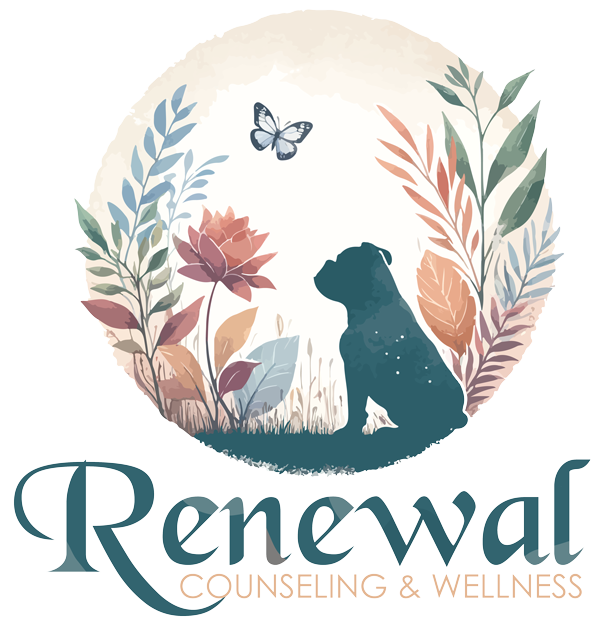Navigating the Waves of Grief: A Compass for Healing
Introduction: Grief is a universal human experience, an emotional journey that we all must undertake at some point in our lives. It is an intricate tapestry of emotions that weaves through the fabric of our existence, leaving an indelible mark on our hearts. In this blog, we will explore the nuances of grief, the waves that crash upon the shores of our souls, and the compass that guides us through the turbulent seas of sorrow.
The Landscape of Grief: Grief is not a linear path but a complex terrain with peaks and valleys. It is a landscape where sorrow, anger, denial, and acceptance are the landmarks that shape our journey. Understanding that grief is a unique experience for each individual allows us to appreciate the diversity of emotions and responses that accompany loss.
The Waves of Grief: Imagine grief as an ocean with waves of varying intensity. Initially, the waves may be overwhelming, crashing relentlessly against the shores of our hearts. Shock, disbelief, and pain may seem insurmountable. As time passes, the waves may subside, only to return unexpectedly, triggered by memories, anniversaries, or even the simplest things. Recognizing these waves and learning to ride them becomes an essential skill in the process of healing.
The Compass of Coping: In the vast expanse of grief, a compass becomes our guide—a set of tools and coping mechanisms that help us navigate the tumultuous waters. Here are some key points on the compass:
- Permission to Grieve: Allow yourself the time and space to grieve. Society often expects a quick recovery, but healing is a personal journey that unfolds at its own pace.
- Seek Support: Reach out to friends, family, or a grief support group. Sharing your feelings with others can provide comfort and understanding.
- Self-Compassion: Be kind to yourself. Grief is not a sign of weakness but a testament to the depth of your love and connection with what or whom you've lost.
- Memorializing: Find meaningful ways to honor and remember your loved one. Creating rituals or dedicating time to reminisce can be healing.
- Professional Help: If needed, consider seeking the support of a therapist or counselor. Professional guidance can provide tools to cope with the complexities of grief.
Conclusion: Grief is a journey that transforms us, leaving us forever changed. It is an expression of love, a testament to the beauty of the connections we forge in our lives. By acknowledging the waves of grief and embracing the compass of coping, we can navigate this intricate terrain and find a path toward healing. Remember, in the ebb and flow of sorrow, there is strength, resilience, and the potential for profound personal growth.
Navigating the Winter Blues: Understanding Seasonal Depression
Introduction:
As the days grow shorter and the temperature drops, many individuals find themselves grappling with a phenomenon known as Seasonal Affective Disorder (SAD), commonly referred to as seasonal depression. This type of depression typically occurs during the fall and winter months when daylight hours are shorter. In this blog post, we will explore the nuances of seasonal depression, its impact on mental health, and effective strategies for coping with the winter blues.
Understanding Seasonal Depression:
- The Science Behind Seasonal Depression: Seasonal depression is believed to be closely linked to the changes in sunlight exposure. Reduced sunlight can disrupt the body's internal clock (circadian rhythm) and affect the production of serotonin and melatonin, neurotransmitters that play a crucial role in mood regulation and sleep.
- Common Symptoms: Individuals experiencing seasonal depression may notice symptoms such as persistent low mood, fatigue, changes in sleep patterns, weight gain, and difficulty concentrating. It's essential to differentiate these symptoms from the typical winter blues, as SAD represents a more severe and persistent form of seasonal mood changes.
Coping Strategies:
- Light Therapy: Light therapy, or phototherapy, involves exposure to a bright light that mimics natural sunlight. This treatment has proven effective in alleviating symptoms of seasonal depression by regulating circadian rhythms and boosting serotonin levels. Consultation with a healthcare professional can help determine the appropriate duration and intensity of light therapy.
- Maintaining a Healthy Lifestyle: Incorporating regular exercise and a balanced diet into your routine can positively impact mood and energy levels. Physical activity releases endorphins, the body's natural mood enhancers, while a nutritious diet supports overall well-being.
- Mindfulness and Relaxation Techniques: Practices such as meditation, deep breathing exercises, and yoga can help manage stress and promote a sense of calm. Mindfulness techniques can be particularly beneficial in navigating the emotional challenges associated with seasonal depression.
- Social Connection: Combat feelings of isolation by maintaining social connections. Engaging in activities with friends or loved ones, even virtually, can provide emotional support and alleviate the sense of loneliness that often accompanies seasonal depression.
- Professional Support: If symptoms persist or worsen, seeking professional help is crucial. Mental health professionals, such as psychologists or psychiatrists, can provide personalized treatment plans, including psychotherapy or medication.
Conclusion:
Seasonal depression is a real and challenging aspect of mental health that affects many individuals during the colder months. By understanding the underlying factors and implementing coping strategies, it is possible to navigate the winter blues and emerge with improved mental well-being. Remember that seeking support from healthcare professionals and maintaining healthy lifestyle habits are essential steps in managing seasonal depression.

The 30 Day Relationship Challenge
When in a relationship, it’s only natural that you experience some bumps in the road. Maybe you’ve hit the end of your “honeymoon phase.” Maybe between work, friends, and family, you can’t remember the last time you said those simple three words. Or, maybe, you’re just in a simple romance rut.
Whatever the case, we’re here to challenge you and your partner to love boldly with our 30-day relationship calendar. Before you get discouraged, these aren’t generic, unrealistic “take a vacation now” tips. Rather, we’ve found 30 simple activities backed by science to improve your romance. Most of the challenges are easy enough to accomplish in the small amount of time you have together and are guaranteed to bring back the fireworks.

The Trauma of Racism
Countless studies have shown the adverse effects of racism.
In the United States, many black people are born into a life of trauma. It is a trauma informed by a long history of brutal inhumanity, repression, violence, and injustice that continues to firmly grip black men and women each and every day.
This trauma is not something any of us who have not had the experience of being black in America can speak to in the same way as someone who has. Yet, acknowledging this trauma and casting it in a broad, unflickering light is all of our responsibility.
Countless studies have shown the adverse physical and psychological effects of racism. “Racism is considered a fundamental cause of adverse health outcomes for racial/ethnic minorities and racial/ethnic inequities in health" (Williams, Lawrence, & Davis, 2019). The experience of individual, institutional, and cultural racism has been found to be uniquely predictive of post-traumatic stress symptoms (Facemire, 2018).
Racial trauma can involve a “negative, sudden, and uncontrollable experience or crisis.” Alternately, it can involve an “ongoing physical or psychological threat that produces feelings of fear, anxiety, depression, helplessness, and post-traumatic stress disorder (PTSD)" (Ponds, 2013).
When you witness the kind of grotesque violence against a man like George Floyd, knowing that this could happen to you or someone close to you simply based on your skin color, how can you not feel threatened, afraid, anxious, depressed, helpless?
Yet, as we all know, for many African Americans this trauma didn’t start with George Floyd. Trauma, in general, can be defined as any significant negative event or incident that shaped us and can emerge from any impactful instance that made us feel bad, scared, hurt, or ashamed. “Acts of aggression are not only examples of interpersonal trauma but also the trauma of racism, which is examined through the lens of intergenerational trauma, racist incident-based trauma, and complex trauma" (Bryant-Davis, Adams, Alejandre, & Gray, 2017).
A black child does not even have to directly experience racism to be influenced. A 2017 systematic review of 30 studies looked at how children’s health might be affected by indirectly experienced racism. Researchers concluded that “socioemotional and mental health outcomes were most commonly reported with statistically significant associations with vicarious racism” (Heard-Garris, Cale, Camaj, Hamati, & Dominguez, 2018). Families living in racially and economically segregated communities must also cope with the effects of historical trauma and intergenerational racism. Additionally, they face specific barriers to obtaining needed services. (“Complex Trauma,” 2010)
Another study that looked at how exposure to racism and other Adverse Childhood Experiences affected perinatal women with moderate to severe mental illness, found that “black women were significantly more likely to report conventional and expanded ACEs including experiencing racism and witnessing violence.” The study concluded that “childhood exposure to racism and environmental trauma are important risk categories for perinatal mental illness” (Kim, Kuendig, Prasad, & Sexter, 2020).
Research on the impact of ACEs has left no doubt that early trauma, especially unresolved trauma, impacts the development of emotional regulation skills and distress tolerance. It can lead to “disrupted neurodevelopment and social, emotional and cognitive impairment” (Aaltonen, 2019). ACEs have further been linked with all the leading causes of death, including illnesses such as heart disease, stroke, obesity, diabetes, and cancer, in addition to mental health concerns like depression, anxiety, substance abuse, and suicide.
The physical and emotional wounds of racial trauma can be reopened throughout one’s lifetime. It’s a trauma reawakened when a person is afraid to walk down the street or is pulled over by the police. It is a trauma reignited by disturbing videos of violence and tragedies like the murder of George Floyd. These events can be triggering on a level that is both deeply personal and broadly shared.
Healing from this kind of trauma must occur on a societal and individual level. Part of overcoming trauma is processing what happened to us, feeling the full pain of it, and making sense of the experience. For many black Americans, the experiences they’re trying to process can be ongoing, complex, and utterly senseless. This makes it all the more crucial that we find pathways to provide mental health services in the wake of trauma.
Unfortunately, although black men are exposed to trauma at an alarming rate, findings have suggested that “56-74% of those exposed to traumatic events may have an unmet need for mental health services” (Motley, Banks, 2018). The question we must ask ourselves, in addition to social change, is what can be done to start to address the mental health needs of this community?
For those impacted by the trauma of racism, healing can come from counseling, spirituality, seeking justice, and social support. Racial socialization messages emphasizing cultural pride have also been found to moderate the relationship between racism and post-trauma reactions (Williams, Lawrence, & Davis, 2019).
Yet, we must ensure access to such resources are available. One effort we made in our hometown of Santa Barbara was to create a volunteer-led Response Network that provides psychological first aid and mental health services after a crisis. At this point in time, all of us in the mental health community should call on one another to increase our efforts to address the trauma that so many people are enduring.
Perhaps what we should marvel at in this moment is not that people have been thrust into action, taking to the streets in protest, but that people imbued with this much trauma have learned to tuck it away for so long, to carry on each day despite its mental and physical toll.
Any help we offer or action we take should include a fuller understanding and acknowledgment of this trauma. It is on all of us to refuse to allow this subject to fall back in the shadows, to keep that light shining, and never allow it to go dark again.
References
Williams, D. R., Lawrence, J. A., & Davis, B. A. (2019). Racism and Health: Evidence and Needed Research. Annual Review of Public Health, 40(1), 105-125. doi:10.1146/annurev-publhealth-040218-043750
Facemire, V. (2018). Understanding the Insidious Trauma of Racism: An Exploration of the Impact of Racial Socialization, Gender, and Type of Racist Experiences. (Electronic Thesis or Dissertation). Retrieved from https://etd.ohiolink.edu/
Ponds, K. T. (2013). The Trauma of Racism: America's Original Sin. Reclaiming Children and Youth, 22(2), 22-24.
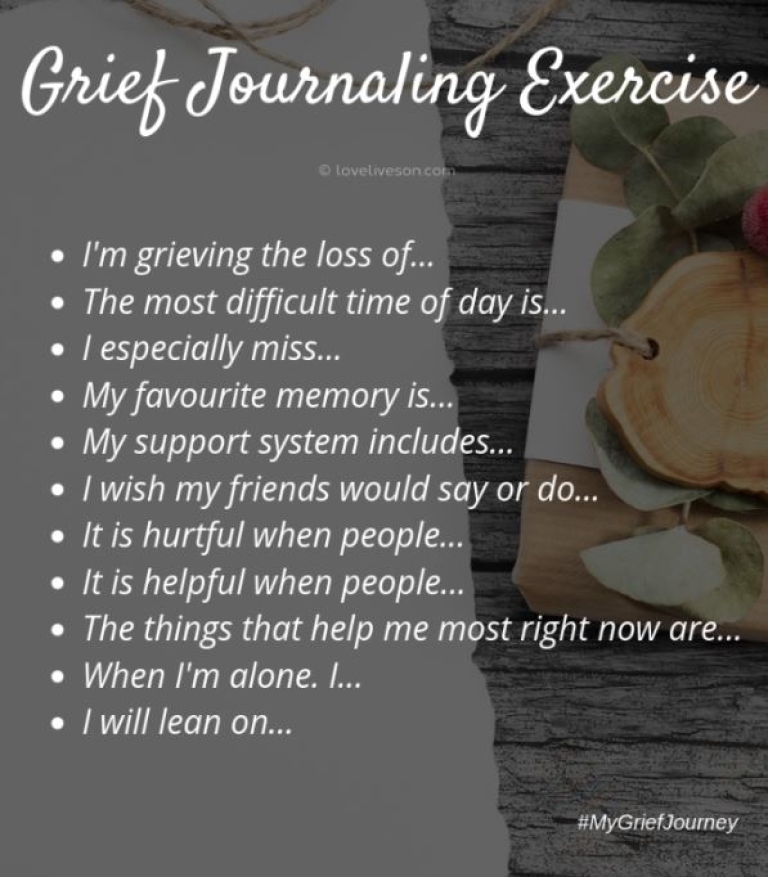
Grief Journaling Prompts
journey.
Putting thoughts on paper gets them out of my head.
Writing them down helps me understand them.

Reading them back is an excellent reflective exercise. It’s a way to track progress, recognize repeating patterns and see where I need to do more grief work.
Sometimes I use Scripture, quotes or other prompts to get me started. Often I may look up words in the dictionary and jot down the definition or synonyms or examples. I may draw my way around a concept or cut out pictures from magazines or the newspaper to add to my creation. There have been days I’ve spent hours and several sheets of paper moving my feelings from my heart to the page.
So if you want to try your hand at journaling, here is a list I find useful.
Don’t set any parameters or have any expectations.
Just write, color, draw or whatever flows naturally.
And if the tears fall, let them.
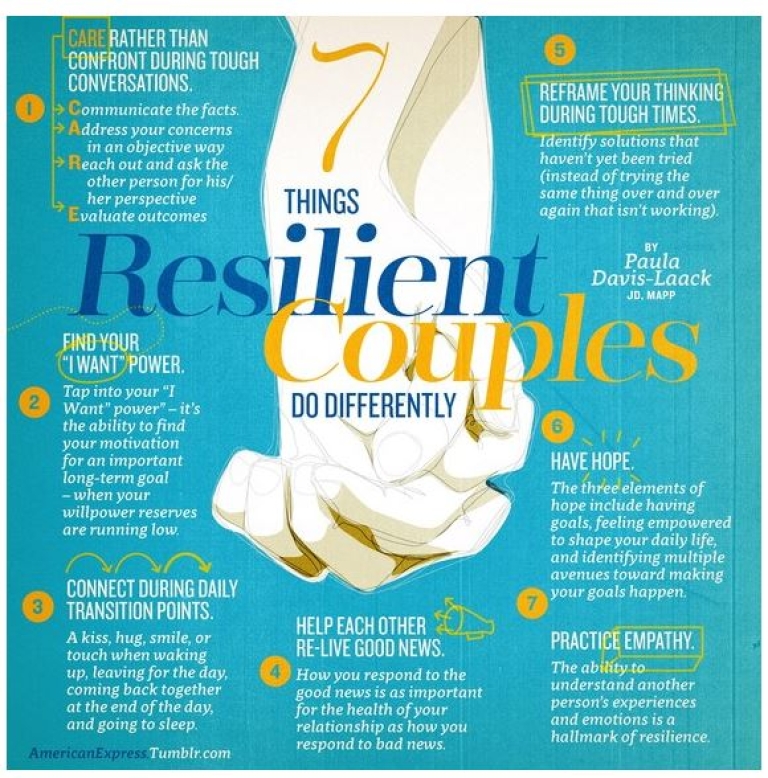
7 Things Resilient Couples Do Differently
My husband and I recently celebrated our 10-year anniversary, and it has caused me to reflect on the twelve years that we have known each other. As a teacher of resilience, defined as the ability to bounce back and grow and thrive during challenge, change and stress, I wanted to examine the traits that helped couples remain resilient. I looked at those relationships that worked, didn't work, and the research to compile these seven hallmarks of resilience in relationships:
1. CARE rather than confront during tough conversations.
Resilient couples know how to communicate assertively -- that is, in a clear, confident and controlled manner. While that's easier said than done, particularly with tough conversations, here's a model to help:
C -- Communicate the facts.
A -- Address your concerns in an objective way
R -- Reach out and ask the other person for his/her perspective
E -- Evaluate outcomes
Most importantly, do your homework before you even have the conversation. Ask yourself whether you have an accurate understanding of the problem. I'm always embarrassed when I have a conversation with someone only to realize I never really fully understood the issue. (1)
2. Find your "I want" power.
Relationships can take a little (and some days, a lot of) self-discipline. Stanford health psychologist, Dr. Kelly McGonigal, coined the phrase "I want" power, and it's an important component of self-control. (2) "I want" power is the ability to find your motivation when it really matters -- that important long-term goal that you want to focus your time and energy on. What are you working toward as a couple? Whatever it is, you need to be able to tap into this "I want" power when your willpower reserves are running low.
3. Connect during daily transition points.
I don't know about you, but my mornings tend to be busy getting ready for the day, and then when I get home from work, I'm exhausted and focused on starting dinner and other tasks. Resilient couples acknowledge each other at distinct transition points during the day: waking up, leaving for the day, coming back together at the end of the day and going to sleep. The acknowledgement can be as simple as a kiss, hug, smile or touch.
4. Help each other relive good news.
Human beings are hard-wired to notice and remember negative news and events. That's why you stand at the ready when your partner says, "Hey, I have a problem!" But what do you do when your partner says, "I've got great news?" How you respond to the good news is as important for the health of your relationship as how you respond to bad news according to psychologist, Dr. Shelly Gable. Killing the conversation by offering a short acknowledgement ("Hey, that's great") or hijacking the conversation by making it about you ("I'm training for that marathon, too!") are quick ways to weaken a relationship.
5. Reframe your thinking during tough times.
When a relationship hits a rough patch, it can be easy to think pessimistically. Thinking optimistically isn't about rainbows and unicorns, rather, it's about being realistic. Optimistic thinkers are able to identify solutions that haven't yet been tried (instead of trying the same thing over and over again that isn't working). In addition, optimistic thinkers zero in on what they can control, influence or leverage. One question I always ask myself during tough times is, "Will I still be dealing with this problem in the next month or year?" Odds are, the answer is no, and that gives me a little perspective.
6. Have hope.
When my ex-fiancé and I broke up years ago, three months before our wedding date, I was devastated. It was one of the times in my life where I felt truly lost and without hope. Whether you're dealing with a sick child, contemplating a divorce or break-up, or wondering how you're going to pay the bills, resilient couples have hope.
The three elements of hope include having goals (identifying pathways); feeling empowered to shape your daily life (remember to zero in on where you have control, influence and leverage); and identifying multiple avenues toward making your goals happen. Hope has been shown to be a strong predictor of satisfaction, even being called a symptom of happiness. (3)
7. Practice empathy.
The ability to understand another person's experiences and emotions is a powerful relationship tool. In addition to promoting forgiveness, empathy is also a hallmark of resilience. Empathetic people tend to be less selfish, having a genuine interest in the well-being of others. (4)
One of my favorite quotes is, "One of the hardest parts of life is deciding whether to walk away or try harder." There are many reasons to both stay in, and leave, a relationship. Choosing to stay requires resilience, and hopefully one of these seven strategies makes a difference in your relationship.
References:
(1) I developed the CARE acronym with my colleague, Lorrie Peniston. It is based on a model of assertive communication created by Sharon Anthony Bower and Gordon H. Bower and is more fully explained in their book, Asserting Yourself: A Practical Guide for Positive Change. New York: De Capo Press. See also Cameron, K. (2008). Positive Leadership: Strategies for Extraordinary Performance San Francisco, CA: Berrett-Koehler Publishers, Inc.
(2) McGonigal, K. (2012). The Willpower Instinct: How Self-Control Works, Why It Matters, and What You Can Do to Get More of It. New York, NY: The Penguin Group.
(3) Gallagher, M.W., & Lopez, S.J. (2009). Positive expectancies and mental health: Identifying the unique contributions of hope and optimism. Journal of Positive Psychology, 4, 548-56.
(4) Skodol, A.E. (2010). The resilient personality. In J.W. Reich, A.J. Zautra & J.S. Hall (Eds.), Handbook of Adult Resilience (pp. 112-125). New York: The Guilford Press.
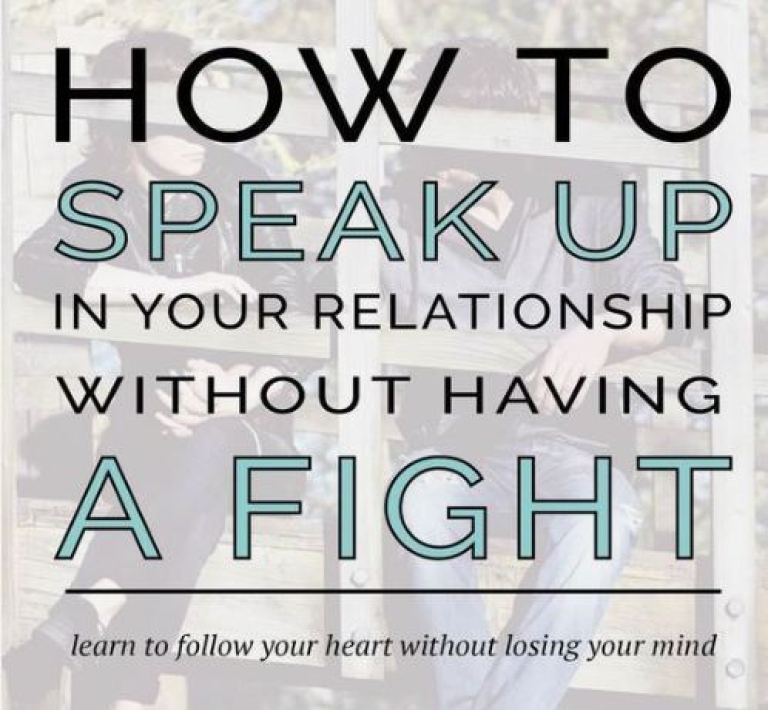
How to Speak Up in Your Relationship Without Having a Fight
The dreaded three words “can we talk,” can immediately stir up defenses. Or maybe those words live on the tip of your tongue, but you just don’t feel like dealing with the spiral downward into the argument abyss, so you never say what is on your heart.
But then, what happens to those concerns, thoughts, worries, and requests that never get said? Do they fester, do you ruminate, do you stuff them? …I am fairly certain they don’t magically disappear. So what are you to do?
At some point, you must speak up. A healthy, happy and lasting relationship requires open communication where you can speak your mind so that these issues do not result in deep resentments that ultimately sabotage your relationship.
So here are some ideas of how to speak up in your relationship without ending up in a fight.
1. EMBRACE AN ATTITUDE OF ABNORMAL IS NORMAL
This one is a mentality shift, and something that may take some time. However, shifting your attitude can be huge in terms of normalizing the need to have conversations about your relationship.
The reality is that relationships are constantly being thrown out of balance. They are regularly in need of attention and adjustments. This is NORMAL.
So, when you need to talk to your partner about an issue, it doesn’t mean that he or she is a bad partner or that your partner is doing a bad job, it means that you are in a NORMAL relationship that requires some maintenance.
Try to talk with your partner about this mentality. Remind him or her at the beginning of a relationship conversation that it is normal to have to make adjustments in how we behave and treat each other.
If you and your partner can get to a place where it is jointly accepted that it is normal to need to talk about your relationship, then these conversations will go more smoothly, and defenses will not be raised at the hint of a “relationship talk.”
2. HAVE REGULAR RELATIONSHIP TALKS
Part of normalizing the need to have talks is to have them regularly, almost like a management meeting. In our couple’s course, Couple LINKS, we refer to this as huddles.
We suggest monthly or even weekly, you and your partner sit down and review your relationship. BTW this isn’t a gripe session…it’s an opportunity to check in with one another. Hit on how things have been going well, and then what needs a bit more attention.
The more you do this, the less likely issues will grow and fester, and the less intimidating these conversations will become.
3. STRIKE WHEN THE IRON IS COLD
So often we hold in issues until they ooze out of us because we can’t contain them anymore. And, more often than not, this happens at the worst times, like when your partner is about to head out of town, or they have an early morning commitment and it’s 10:30 at night.
The tip here is to bring up an issue when things are going well. When you have some downtime together and are in a good place, say something like, “Hey, I’ve been wanting to talk with you about something, you think you’d be up for it?”
Trying to talk about issues when it’s tense, when you’re about to overflow with emotion or frustration, or when time is tight doesn’t go well. So get in there when all is good!
(I wrote a post about Fighting Fair that may also be worth a read….you can check it out here)
4. STICK TO ONE ISSUE AT A TALK
I’m certain this has happened to me. When you begin a relationship talk and suddenly you’re talking about all the issues you have been bottling up, giving examples, and trying to explain everything that has ever bothered you. And then you realize, you’ve lost your point. This is an example of “partner overload.” Seriously, who can hear all those things at once and not feel totally defeated or defensive.
Next time, choose one issue. One point you’d like to discuss and ONLY talk about that point. This will help you to keep it clear and it will also help your partner not to feel like you are attacking from all sides.
5. DON’T GET SUCKED INTO ARGUING EXAMPLES
This is another relationship talk trap. It’s when you start by bringing up one issue and your partner says, “When did I do that?” or “Give me an example.” Ok, so watch your step. It’s totally acceptable to give an example, and even recommendable to have an example already in mind, but don’t get sidetracked into arguing the details of that example.
It’s common for the partner on the defensive to argue that the example given was an exception, not the rule. But, chances are, if you’ve come to the point of needing to talk about something, then it isn’t the exception.
So, handle it like this, “I don’t want to argue every example because I am sure there are reasons for why you did or said _______________. However, when ___________________ happens, I feel upset and want you to know. In the future, I would like _______________ to happen instead.”
Obviously, you may need to customize my suggestion, but the takeaway is to give one or two examples (not more), and then get back to your main issue. Continue to center the conversation on the overarching pattern, because your point is that there is a pattern of x,y,z that upsets you, and you would like your partner to know and make a change. So keep the big picture at the forefront of your conversations.
6. WATCH THE CLOCK
You probably went into the talk with good intentions, but now the talk has dragged on, and you’ve lost any chance of the issue getting resolved. This can happen when the relationship talk just went overboard. It went on way too long.
Work to keep your talks to 30 minutes or less. This can help your partner from glazing over, or things erupting into something bigger. This is important because you don’t want your relationship talks to be so draining that you avoid them in the future. Try to keep any of your negative talks short and to the point.
7. TIP THE SCALES
The final suggestion that I have is to make sure you have significantly more positive than negative talks. Step back and look at the overall mood of your togetherness. Are your negative talks an exception, or do they seem like a bitter seasoning that is sprinkled throughout your time together? Make an intentional increase of your compliments, your expressions of appreciation, and your relaxed and enjoyable conversations so that when you need to bring up an issue, it is with a backdrop of respect and security.
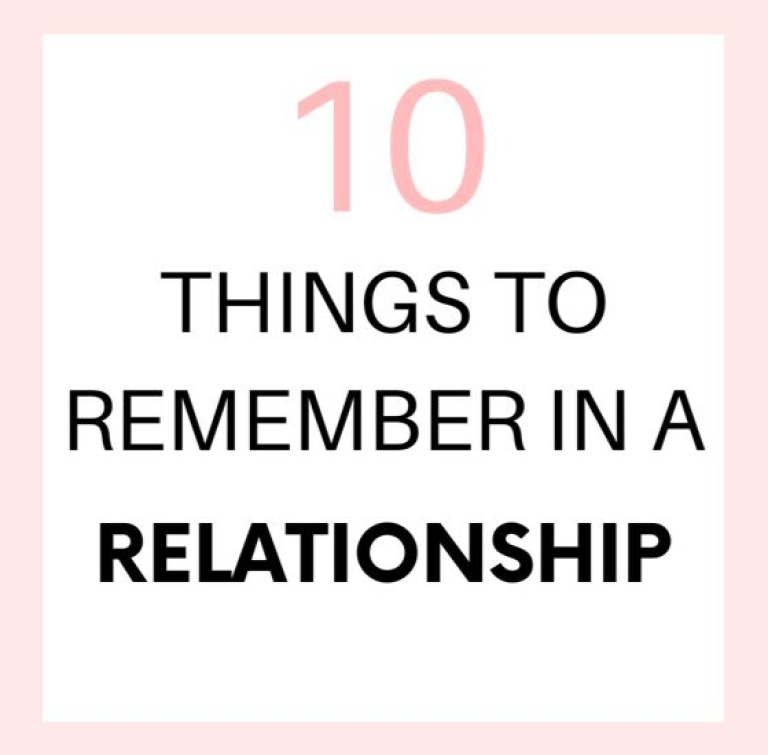
10 THINGS TO REMEMBER IN A RELATIONSHIP…
No relationship is perfect. Every relationship takes work each and every day. You are constantly learning something new about each other. There will be times when you may not see eye to eye and there will be times when you may not agree. I am currently in an almost 8 year relationship and I have learned
There will be times when you make each other upset or maybe you won’t agree. It is so important to make sure that you are communicating your feelings with one another. Your partner is not a mind reader. (sometimes I forget this!) When you and your partner are feeling upset, communicate it! It’s important to always let each other know when you are upset because if you don’t, the problem may never get resolved. You can only make each other happy if you know how to.
It’s also important to try to remember to communicate when you are happy too. I know that my partner appreciates when I let him know just how happy I am when he does something that puts a smile on my face. Whether it be watching a tv show with me or doing something without me having to ask. It just makes your partner feel noticed and appreciated. It also let’s your partner know what makes you happy and what you like.
THE 5 LOVE LANGUAGES
If you have never heard of the five love languages then let me explain a little.
A love language is the way you “receive love.” I once read this book “The 5 Love Languages” by Gary Chapman and learned a lot!! I recommend this book to everyone. You can receive love 5 different ways; through: acts of service, words of affirmation, physical touch, receiving gifts, or quality time. It’s essential to figure out you and your partners love language so that you can show each other love in the correct ways.
Remember that your love language can be different than your partners. The way you enjoy receiving love is not always the same way your partner enjoys receiving love. Sometimes we forget that and instead of showing our partner love the way they want, we end up showing them love the way we want.
This book really changed the way I viewed my relationship and it also made me a more loving partner.
You can also take the quiz & find out your love language here
NEVER GO TO BED UPSET
I’ve learned that going to bed upset makes everything worse. Not to mention it can cause some serious nightmares! It can be upsetting to lay next to the one you love or like a lot, knowing they are upset with you. Always communicate your problems and make sure you two can go to bed happy with each other.
ALWAYS DISCUSS, TRY NOT TO ARGUE
I know this can be a tricky because when we get upset we tend to raise our voices hoping to get a point across. Yelling can back fire and make a situation worse. I find that talking respectfully and discussing issues in a mild tone gets the point across much better than yelling back and forth. If you do feel as if you need to step away for a minute to collect your thoughts and take a deep breath, you should absolutely do so! Trying to discuss things while you are extremely frustrated or upset can also lead to hurtful words that you don’t mean.
BE HONEST
Don’t lie or try and hide anything from one another. It is important to be open and honest with your partner. If your partner finds out from another source (which he/she eventually will) it can lead to disappointment, arguments, and trust issues. Avoid this easily by being honest.
SHOW AFFECTION, KEEP THE ROMANCE ALIVE
Have you ever heard someone say, “Are you two still in the honeymoon phase?” I sure have. Then I find myself wondering, the honeymoon phase has to come to an end? The answer is, no, it really doesn’t. Show love and affection towards each other daily and that honeymoon phase will never end.
I know some days are busier than others but, to make the effort to kiss each other day and night is quite a simple task. Don’t you think? Or even complimenting each other daily. Try to cook dinner and have a romantic night in just the two of you, once a week. Why not? Although I know with children it can be hard at times. Don’t give up though. Always kiss each other goodnight.
QUALITY TIME IS IMPORTANT
It’s important to remember to make time for one another. Life can get busy and we can get caught up in our daily routines. Set aside time where you can spend it without any company or electronic device. Do something fun or relaxing. Whatever you love to do together.
GO OUTSIDE YOUR COMFORT ZONE
You will appreciate keeping the relationship exciting. Go out of your comfort zones and try something new together. Whether it be a new restaurant or activity such as sky diving! (okay it doesn’t have to be that extreme, but you get my point!) Have some fun! It can also rekindle that flame!
LISTEN TO AND SUPPORT YOUR PARTNER
Be your partners biggest supporter. Always listen to your partner when he/she is talking to you. Be engaged in the conversation. If your partner is having a tough day, be there. Always try and lift one another up. You will see each other’s darkest and brightest days. It’s always nice to know you have a shoulder to lean on whenever you need it.
DON’T COMPARE YOUR RELATIONSHIP EVER
It’s so easy to compare your relationship to someone else’s. Why is it that, as humans, we always look for more? We are never happy with what we have? Or maybe we are, we just fail to appreciate it. When you start to compare your relationship to someone else’s, you start to be unappreciative of what you have. No relationship is the same and no relationship is perfect.
It may look like “Jim and Sally” have a “perfect” relationship on the outside but you don’t know what it’s really like. The only way to know, is if you were them. Focus on your relationship and the reasons why you are in it.
Relationships are a lot of work, but when you are with the right person, it’s all worth it.
I am not here to tell anyone that their relationship is right or wrong. This is just what helps me keep my relationship healthy and growing, almost 8 years and counting!
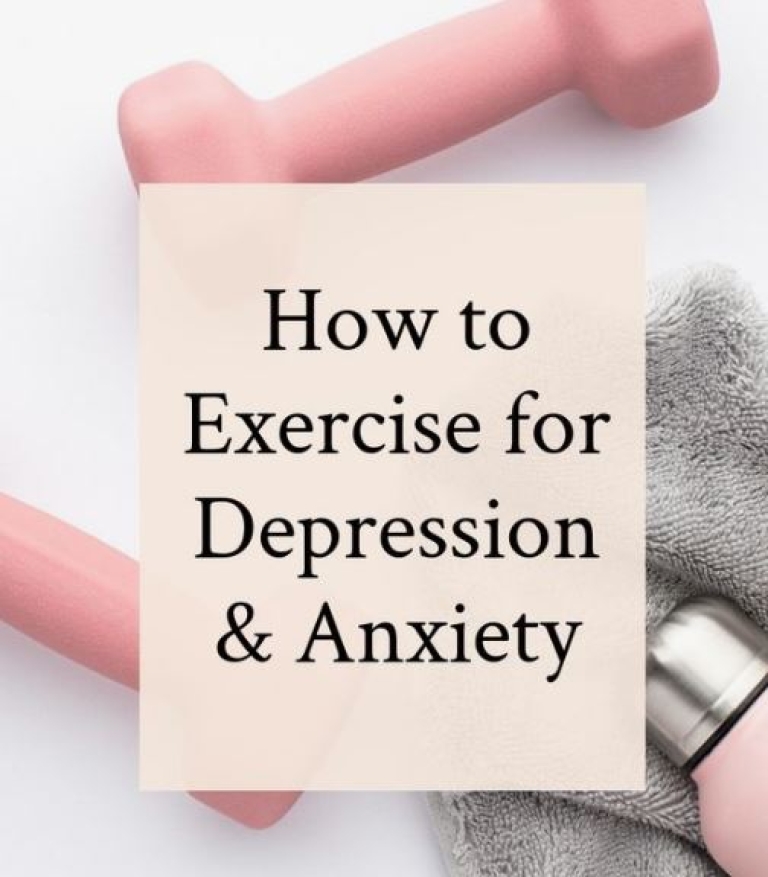
Exercise and Mental Health: How much is too much?
Keep reading to find out how to have a balanced exercise routine that supports you mentally and physically.
We all know that regular exercise is one of the best things you can do support your physical health. Countless research studies have documented the health benefits of exercise, ranging from increased strength and energy to decreased risk of diabetes and even all-cause-mortality.
In my practice, I talk about exercise a lot as it relates to mental health. Exercise is my number one recommendation when it comes to boosting your mood, increasing energy, and managing stress. Studies have even found that exercise may be just as effective as anti-anxiety and antidepressant medications in treating and preventing mild-to-moderate depression and anxiety (1).
When it comes to the mental health benefits of exercise, it’s important to keep in mind that more exercise doesn’t always mean more benefits. Overexercising can actually make your mental and physical health worse, especially if you suffer with anxiety, depression, disordered eating/eating disorders, poor body image, and hormone imbalances.
So how much is too much when it comes to exercise? And how can you reap the benefits of exercise for mental health without overdoing it? Keep reading to learn how to support your mental health with a balanced exercise routine.
The Science Behind Exercise and Mental Health
First let’s start with why exercise is so important for mental health. If you struggle with concentrating, depression, anxiety, stress, and/or addiction there are a ton of science-backed reasons why you should start exercising to support your mental health.
01 - IMPROVES MEMORY AND LEARNING
Several studies in animals and humans have found that exercise increases the number of new neurons in the brain, a process known as neurogenesis.
Physical activity increases brain-derived neurotrophic factor (BDNF), a growth factor that stimulates neuron growth and protects against neuron degeneration. Neurogenesis has been found to increase brain volume and improve learning and memory.
Declining neurogenesis may also be implicated in the development of certain mental illnesses, including Alzheimer's disease, schizophrenia, and depression.
02 - ACTS AS A NATURAL ANTIDEPRESSANT
Scientists have yet to understand the specific causes of depression, but have identified several neurotransmitters that are involved in the development of the of the disease.
Serotonin is a powerful neurotransmitter that is targeted in many antidepressant medications, including selective serotonin reuptake inhibitors or SSRIs. Serotonin helps us feel motivated and increases our willpower and mood.
Exercise and movement in general, increases the release of serotonin, which has a natural antidepressant effect on the brain. Serotonin also has the added bonus of stimulating the production of BDNF and neurogenesis!
03 - INCREASES CONCENTRATION
Deep thinking and concentration are functions of the brain's norepinephrine system. Norepinephrine is a neurotransmitter involved in the body's stress response that has several functions, including enhancing concentration and focus.
Some antidepressant medications also target the norepinephrine system. Exercise increases the release of norepinephrine, especially intense physical activity, helping you to feel focused and productive.
04 - REDUCES PAIN + ANXIETY
Ever wonder where the term "runner's high" comes from? Physical activity actually causes your brain to release the same neurotransmitters that are responsible for the "high" sensation felt with opiate and marijuana use.
These neurotransmitters are called endorphins, which have the powerful effect of reducing pain and relieving anxiety. Endorphin release also increases with the intensity of exercise, so the more you sweat the happier (or higher) you feel.
This is also one of the reasons why it can be hard to know when you are overexercising. Your endorphins can mask some of the symptoms of pushing your body too hard, but more on this soon…
Physical activity also activates the endocannabinoid system, further reducing pain sensitivity and providing an improved sense of well-being.
05 - HELPS TO MANAGE ANXIETY
Several studies have found that exercise can help decrease your sensitivity to anxiety. In other words, people who exercise regularly are less likely to experience anxiety in moments of perceived stress. Exercise stimulates the stress response in a similar way that anxiety does - increased heart rate, sweating, increased breathing rate.
Researchers theorize that exposing someone with high anxiety sensitivity to the physiological symptoms they fear, such as rapid heartbeat, in the context of physical exercise increases their tolerance for such symptoms.
06 - HELPS WITH ADDICTION
Dopamine is the brain's primary neurotransmitter involved in addiction. The brain releases dopamine in response to a pleasurable stimulus. Addictive substances, foods, and behaviors can cause a quick and intense release of dopamine into the brain.
Repeated exposure to that substance, food, or behavior can eventually cause a physiological addiction.
Studies have found that just 10 minutes of physical activity can significantly alter dopamine circuits and increase your willpower to avoid addictive substances, foods, and behaviors.
Bottom Line
Regular exercise supports mental health and wellbeing in several different ways, including boosting your mood, decreasing anxiety, improving focus, memory and learning, and helping with addiction.
How to Find a Balanced Exercise Routine
Even though exercise is one of the best ways to manage your mental health, you can overdo it and actually make your mental health worse!
A new research study published in The Lancet Psychiatry looked at data from 1.2 million people in the US to learn more about which types and how much exercise has the most benefits for mental health.
The study found that team-oriented sports, cycling, and aerobic exercise for 30 - 60 minutes, 3 - 5 times a week had the most benefits for mental health. People who practiced this exercise routine reported having fewer days of poor mental health, especially those who were diagnosed with depression.
The study also found that any type of physical activity, including chores around the house, walking, gardening, etc. had a positive impact on mental health. Overall, people who exercised regularly had a 43% decrease in poor mental health days per month.
Recommended Reading: Tips and Tricks for Consistent Exercise
Interestingly, the study also found that exercising more than 23 times a month or for longer than 1.5 hours was associated with worse mental health.
It’s important to keep in mind that, like most things in wellness, there is no one size fits all routine for exercise and it takes experimenting and some trial and error to find out the best plan for you.
That being said, there are some common symptoms of overexercising that you should look out for. Especially if you suffer from anxiety, depression, disordered eating/eating disorders, body image issues, and hormone imbalances.
-
Persistent aches and pains in your muscles and/or joints - it’s normal to feel sore 24 - 48 hours after a workout, but if your muscles and joints hurt all the time this is a sign you are working your body too hard and not getting enough time for rest and recovery.
-
Feeling light-headed or dizzy on workout days - this is a classic sign of overexercising and also under eating. Your blood sugar or blood pressure might be dropping too low because you are not getting enough carbohydrate or electrolytes, respectively. Bottom line - if you want do more intense exercise, you have to fuel and hydrate appropriately.
-
Frequent headaches on workout days - this is another sign you might be overexercising, under eating, not hydrating enough and/or not sleeping enough to support a more intense workout routine.
-
Having difficulty getting through a workout - While it’s true that pushing your limits at the gym can help you get stronger and build more muscle. It’s also true that pushing yourself too hard can cause more stress on the body. If you can’t make it through a workout, then try scaling back the intensity and build your way up to harder workouts as you get stronger. You should feel energized, not chronically fatigued when exercising.
-
Difficulty breathing - This could be a sign of iron deficiency anemia or other conditions that may limit your ability to get enough oxygen (ex. sleep apnea). Make sure you correct these deficiencies before you do intense cardio.
-
Prioritizing workouts over sleep - Sleep is an essential component of recovery. If you aren’t getting a good night’s sleep you should limit intense physical activity and opt for more gentle movement like walking, stretching, strength training, yoga, or pilates.
-
Repeat injuries and/or sickness - Overexercising can cause immunosuppression, making you more prone to getting sick. Constant wear and tear on your muscles, bones, and ligaments without adequate rest and recovery also makes you more prone to injury.
-
Changes in your menstrual cycle and/or libido - Amenorrhea and dysmenorrhea are two of the biggest signs that you are working your body too hard. If you stop getting your period or your period starts to come less often, this is a sign that exercise is impacting your hormones. Overexercising can also cause inflammation that decreases your libido.
-
Weight gain - Overexercise can trigger intense hunger, which can lead to overeating and even binge eating. Too much exercise stimulates inflammation that decreases thyroid function and increases stress hormones, both of which can cause weight gain.
You can read more about the science behind overexercise in this great article by Laura Schoenfeld, RD: Are you overtraining? 9 Important signs that you need to exercise less.
Bottom Line
Exercise should be used as a tool to support your physical and mental health, and not as a way to punish your body. You should feel energized and strong after a workout, not tired and weak. The goal is to train smarter, not harder and find a balanced exercise routine that works for your body, mind, and lifestyle.
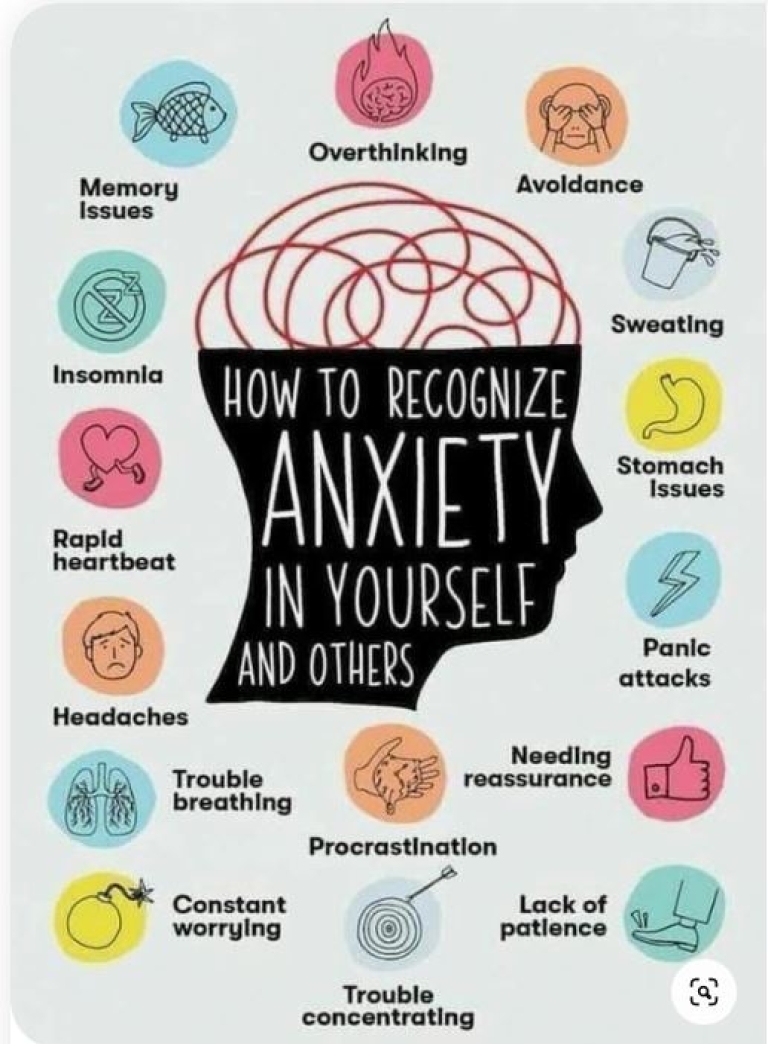
Holistic/Alternative/Natural Therapy to melt your stress and feel relaxed and re-energized!
Clear your negative energy & toxicity by simple Mind Detox. Liberate yourself & Empower yourself, no matter what you been through Holding resentment or negative energy you sabotage your own Growth. It is necessary to recognize Anxiety & Depression as soon as possible, to take proper steps to get out of them. Don't hide or live with them. Don't sulk inside. Be wise and bold enough to look for solutions. They are destructive for both mental and physical health. Help yourself and your loved one.
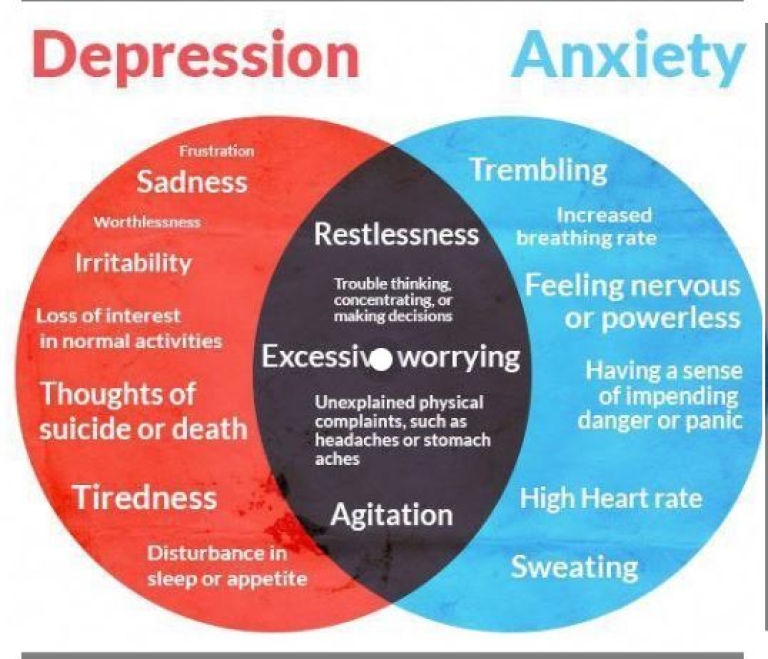
7 Common Causes Of Anxiety & Depression
HERE ARE 7 COMMON LIFESTYLE CAUSES OF DEPRESSION AND ANXIETY:
1. SUBSTANCE ABUSE
People abuse substances such as recreational drugs and alcohol for a number of reasons. Substance abuse is a habit that may form at any time, including childhood and teenage years.
Individuals susceptible to depression and anxiety who engage in drug use are more likely to develop mental illness.
2. OVERWORKING
Becoming exhausted because of too much of a heavy workload causes stress reactions within the body. Most people today concede that they’re at least moderately impacted by stress caused from work.
When the brain is exposed to chronic stress, it’s delicate chemical balance is interrupted. Again, those individuals prone to anxiety and depression for whatever reason – and are exposed to long-term stress – are prone to anxiety and depression.
3. GRIEF AND TRAUMA
A common talking point in the news is the prevalence of Post-Traumatic Stress Disorder (PTSD) in military members. Being a witness or victim of violence of any kind can trigger a biological reaction that evolves into full-blown anxiety and depression.
Feelings of grief following the death of a loved one or friend, though uncomfortable, can serve as a good healer. However, prolonged grief in susceptible demographics can cause mental health issues.
4. HEALTH CONDITIONS
People diagnosed with untreatable health conditions may be at an increased risk of becoming depressed. Age-related illnesses or diagnoses of terminable condition such as Parkinson’s Disease, Alzheimer’s, cardiovascular disease, or cancer often induce feelings of panic and helplessness; of course, prolonged exposure to these feelings can manifest into anxiety and depression.
It is also worth mentioning that the changes of an anxiety/depression diagnosis increases with age, per WebMD.
5. SUDDEN AND STRESSFUL CHANGES
During the infamous Wall Street Crash of 1929, which led to the loss of billions of dollars and laid the foundation for the Great Depression, 23,000 people committed suicide – at the time, the highest number of suicides ever in one year.
While the number of people who killed themselves due to anxiety and depression cannot be ascertained; it is fair to assume that the mental illness had played a role.
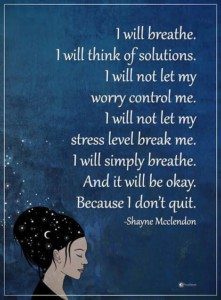
6. POOR SELF-IMAGE
Finding accurate statistics and facts people with low self-image (self-esteem) is quite difficult. Across sources, a few common outliers:
– Females are more likely than males to have self-esteem issues
– People with self-esteem problems are more likely to engage in behaviors considered a health risk (smoking, alcohol and substance abuse, poor diet)
– There is a correlation between negative self-image and suicide
A continually negative picture of oneself can lead to obsessive thought patterns; about appearance, money, reputation, and so on. In a worst case scenario, the brain’s neurochemistry is altered, producing depressive and anxious symptoms or conditions.
7. ISOLATION OR REJECTION
As human beings are naturally social creatures, we require social interaction to function properly. Human beings also long for intimacy; another person to care for, love, and support them.
Isolation, voluntary or involuntary separation from other human beings; and rejection, refusal of others to accept or consider you as part of something, are counterintuitive to the brain’s innate social cognitive functions. As a result, the brain adopts opposing thought processes, and forms neural networks, that disturb it’s natural chemistry.
In short, isolation and/or rejection can lead to a neurochemical imbalance that manifests into anxiety and depression.
Finally…
Should you or someone you know potentially suffer from an anxiety or depression-related illness, there are a variety of effective treatment options available.
Therapists, support groups, medical professionals, and many others are there to help resolve the issue.
In other words, you are not alone. Don’t be afraid to get help!
